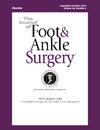Weight-bearing timing after the operative management of ankle fractures: Single center audit and critical appraisal of literature
IF 1.3
4区 医学
Q2 Medicine
引用次数: 0
Abstract
The postoperative weight-bearing policy following internal fixation of unstable ankle fractures varies greatly and is largely surgeon-dependent. While early weight-bearing is favoured for its superior functional and economic outcomes, late weight-bearing may be safer initially. However, consensus on the preferred treatment protocol is lacking. We audited practices at University Hospitals Leuven, Belgium, comparing them to existing literature to establish an updated protocol.
In a retrospective study of 236 patients with unstable ankle fractures, we compared outcomes between early (EWB) and late weight-bearing (LWB) strategies, with or without braces and/or vacuum casts. Most patients followed a LWB protocol, while EWB was reserved for younger, lower BMI individuals. The difference in brace or vacuum cast usage was insignificant. All open fractures followed a LWB protocol. No disparities in union rates, complications, or length of stay were found between EWB and LWB. Surgical management cost €6,419 (6,921 US $) on average, with length of stay being the main cost driver. Total healthcare costs did not differ significantly between EWB and LWB. FRI was revealed in 6 cases, (1 [4%] vs. 5 [2.5%], EWB vs. LWB respectively, P=0.922)
In conclusion, while no significant differences in outcomes were observed between EWB and LWB rehabilitation, differences in group characteristics may have influenced these findings. Despite limited EWB cases, it appears safe for younger patients with low BMI. Vacuum casts and braces aid in EWB. Reducing length of stay, rather than restricting orthotic use, may help control healthcare costs.
踝关节骨折手术治疗后的负重时机:单中心审计和文献批判性评估。
不稳定踝关节骨折内固定术后的负重政策差异很大,主要取决于外科医生。早期负重因其卓越的功能和经济效益而受到青睐,而晚期负重在初期可能更为安全。然而,对于首选的治疗方案还缺乏共识。我们对比利时鲁汶大学医院的做法进行了审核,并将其与现有文献进行比较,以制定最新的治疗方案。在一项针对236名不稳定踝关节骨折患者的回顾性研究中,我们比较了早期(EWB)和晚期(LWB)负重策略的治疗效果,无论是否使用支具和/或真空石膏。大多数患者都采用了 LWB 方案,而 EWB 仅适用于较年轻、体重指数较低的患者。在使用支具或真空石膏方面的差异并不明显。所有开放性骨折均采用 LWB 方案。在愈合率、并发症或住院时间方面,EWB和LWB均无差异。手术治疗的平均费用为 6419 欧元(6921 美元),住院时间是主要的费用驱动因素。EWB 和 LWB 的总医疗费用没有明显差异。总之,虽然 EWB 和 LWB 康复治疗的结果无显著差异,但群体特征的不同可能会影响这些结果。尽管 EWB 案例有限,但对于体重指数较低的年轻患者来说似乎是安全的。真空石膏和支架有助于 EWB。缩短住院时间,而不是限制矫形器的使用,可能有助于控制医疗成本。
本文章由计算机程序翻译,如有差异,请以英文原文为准。
求助全文
约1分钟内获得全文
求助全文
来源期刊

Journal of Foot & Ankle Surgery
ORTHOPEDICS-SURGERY
CiteScore
2.30
自引率
7.70%
发文量
234
审稿时长
29.8 weeks
期刊介绍:
The Journal of Foot & Ankle Surgery is the leading source for original, clinically-focused articles on the surgical and medical management of the foot and ankle. Each bi-monthly, peer-reviewed issue addresses relevant topics to the profession, such as: adult reconstruction of the forefoot; adult reconstruction of the hindfoot and ankle; diabetes; medicine/rheumatology; pediatrics; research; sports medicine; trauma; and tumors.
 求助内容:
求助内容: 应助结果提醒方式:
应助结果提醒方式:


